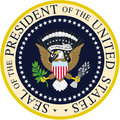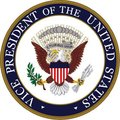James Buchanan
|
|
| ||||||||||||||||||||||||||||
James Buchanan (April 23, 1791 – June 1, 1868) was the 15th (1857-1861) President of the United States. He was the only bachelor President, and the only resident of Pennsylvania to hold that office. He has been criticized for failing to prevent the country from sliding into schism and the American Civil War and as a result, he is widely considered to be the worst president in U.S. History. In a survey conducted by C-SPAN that ranked American presidents, a panel of historians rated him last overall and the general populace rated him last as well[1] (http://home.nyc.rr.com/taranto/presidents.htm).
| Contents |
Biography
Buchanan was a Representative and a Senator from Pennsylvania. He was born in a log cabin at Cove Gap, near Mercersburg, Franklin County, Pennsylvania, on April 23, 1791 to James Buchanan and Elizabeth Spear. He moved to Mercersburg with his parents in 1799, was privately tutored and then attended the village academy and was graduated from Dickinson College, Carlisle, Pennsylvania. In 1809 he moved to Lancaster, Pennsylvania. The same year he studied law, and was admitted to the bar in 1812 and practiced in Lancaster. He was one of the first volunteers in the War of 1812 and served in the defense of Baltimore, Maryland. He was a member of the Pennsylvania State House of Representatives from 1814 to 1815. He was elected to the Seventeenth and to the four succeeding Congresses (March 4, 1821 - March 3, 1831). He was chairman of the Committee on the Judiciary (Twenty-first Congress). He was not a candidate for renomination in 1830. Buchanan served as one of the managers appointed by the House of Representatives in 1830 to conduct the impeachment proceedings against James H. Peck, judge of the United States District Court for the District of Missouri. Buchanan served as Minister to Russia from 1832 to 1834.
The woman to whom Buchanan was once engaged died a few days after she broke off the engagement, and Buchanan then vowed to never marry. Buchanan was close friends with senator William Rufus King, and for some years lived with him in Washington, D.C.. Rumors and speculation that the two had a homosexual relationship began at the time and have periodically been revived by historians, but there isn't any decisive evidence one way or the other.
Buchanan was elected as a Democrat to the United States Senate to fill the vacancy caused by the resignation of William Wilkins. He served from December 6, 1834; was reelected in 1837 and 1843, and resigned on March 5, 1845, to accept a Cabinet portfolio. He was chairman of the Committee on Foreign Relations (Twenty-fourth through Twenty-sixth Congresses).
Buchanan served as Secretary of State in the Cabinet of President James K. Polk from 1845 to 1849, during which he negotiated the 1846 Oregon Treaty establishing the 49th parallel as the northern boundary in the western U.S. No Secretary of State has become President since James Buchanan.
He served as Minister to the United Kingdom from 1853 to 1856, during which time he help to draft the Ostend Manifesto which proposed the purchase of Cuba under the threat of force.
Presidency
Buchanan was elected as a Democratic President of the United States in 1856 and served from March 4, 1857, to March 4, 1861.
In regard to the growing schism in the country, as President-elect he intended to sit out the crisis by maintaining a sectional balance in his appointments and persuading the people to accept constitutional law as the Supreme Court interpreted it. The Court was considering the legality of restricting slavery in the territories, and two justices hinted to Buchanan what the decision would be.
In his Inaugural Address, besides promising not to run again, Buchanan referred to the territorial question as "happily, a matter of but little practical importance" since the Supreme Court was about to settle it "speedily and finally."
Two days later Chief Justice Roger B. Taney delivered the Dred Scott Decision, asserting that Congress had no constitutional power to exclude slavery in the territories. Much of Taney?s written judgment is widely interpreted as dicta — statements made by a judge that are unnecessary to the outcome of the case, which in this case, while they delighted Southerners, created a furor in the North. Buchanan was widely believed to have been personally involved in the outcome of the case, with many Northerners recalling Taney whispering to Buchanan during Buchanan's inauguration. Buchanan wished to see the territorial question resolved by the Supreme Court. To further this, Buchanan personally lobbied his fellow Pennsylvanian Justice Grier to vote with the majority in that case to uphold the right of slave property.
Buchanan, however, faced further hardship on the territorial question. Buchanan threw the full prestige of his administration behind congressional approval of the Lecompton constitution in Kansas, which would have admitted Kansas as a slave state, going so far as to offer patronage appointments and even cash bribes in exchange for votes. The Lecompton government was wildly unpopular to Northerners, as it was dominated by slaveholders who had enacted laws curtailing the rights of non-slaveholders. Even though the voters in Kansas had rejected the Lecompton Constitution, Buchanan managed to ram his bill through the House, but it was blocked in the Senate by Northerners led by Stephen A. Douglas. Eventually, Congress voted to call a new vote on the Lecompton constitution, a move which infuriated Southerners. Buchanan, meanwhile, was by now tremendously unpopular in the North.
Economic troubles also plagued Buchanan's administration with the outbreak of the Panic of 1857. The government suddenly faced a shortfall of revenue, due in part to the Democrats' successful push to lower the tariff. Buchanan's administration, at the behest of Treasury Secretary Howell Cobb, began issuing deficit financing for the government, a move which flew in the face of two decades of Democratic support for hard-money policies and allowed Republicans to attack Buchanan for financial mismanagement.
When Republicans won a plurality in the House in 1858, every significant bill they passed fell before southern votes in the Senate or a Presidential veto. The Federal Government reached a stalemate. Bitter hostility between Northern and Southern members prevailed on the floor of Congress, where memories of the caning of Charles Sumner in 1856 by a Southern Democrat still burned.
Sectional strife rose to such a pitch in 1860 that the Democratic Party split. The southern wing walked out of the convention and nominated its own candidate for the presidency, incumbent vice-president John C. Breckinridge, whom Buchanan refused to support. Consequently, when the Republicans nominated Abraham Lincoln, it was a foregone conclusion that he would be elected even though his name appeared on no southern ballot. Rather than accept a Republican administration, the southern "fire-eaters" advocated secession.
President Buchanan, dismayed and hesitant, denied the legal right of states to secede but held that the Federal Government legally could not prevent them. He hoped for compromise, but secessionist leaders did not want compromise.
Then Buchanan took a more militant tack. As several Cabinet members resigned, he appointed northerners, and chartered the civilian steamer Star of the West to secretly carry reinforcements and supplies to Fort Sumter. However, the attempt to maintain secrecy failed. Newspapers published stories that the ship was headed for Charleston, and South Carolina officials received confirmation from Louis Wigfall, still a United States senator from Texas, as well as from Buchanan's secretary of the interior, Jacob Thompson of Mississippi. In the early morning of January 9, 1861, South Carolina's batteries opened on the Star of the West. The unarmed ship was caught in a cross-fire. Receiving no assistance from Fort Sumter, it turned back to New York after suffering minor damage. As a result of the operation, Thompson resigned from the cabinet.
As such, the first shots of the American Civil War were fired during the Buchanan Administration. Before he left office, seven slave states seceded, several seizing other federal forts and property within their boundaries.
Buchanan retired to his home "Wheatland," near Lancaster, Pennsylvania, where he died June 1, 1868, at the age of 77. He was interred in Woodward Hill Cemetery, in Lancaster. "Wheatland" should not be confused with the Wheatland musical organization.
Cabinet
| OFFICE | NAME | TERM |
| President | James Buchanan | 1857–1861 |
| Vice President | John C. Breckinridge | 1857–1861 |
| Secretary of State | Lewis Cass | 1857–1860 |
| Jeremiah S. Black | 1860–1861 | |
| Secretary of the Treasury | Howell Cobb | 1857–1860 |
| Phillip F. Thomas | 1860–1861 | |
| John A. Dix | 1861 | |
| Secretary of War | John B. Floyd | 1857–1861 |
| Joseph Holt | 1861 | |
| Attorney General | Jeremiah S. Black | 1857–1860 |
| Edwin M. Stanton | 1860–1861 | |
| Postmaster General | Aaron V. Brown | 1857–1859 |
| Joseph Holt | 1859–1861 | |
| Horatio King | 1861 | |
| Secretary of the Navy | Isaac Toucey | 1857–1861 |
| Secretary of the Interior | Jacob Thompson | 1857–1861 |
Supreme Court appointments
Buchanan appointed the following Justice to the Supreme Court of the United States:
- Nathan Clifford - 1858
States admitted to the Union
- Minnesota – May 11, 1858
- Oregon – February 14, 1859
- Kansas – January 29, 1861
Related articles
History Clipart and Pictures
- Pictures of the US Presidents (http://classroomclipart.com/cgi-bin/kids/imageFolio.cgi?direct=History/United_States/Presidents)
- Clipart of American Presidents (http://classroomclipart.com/cgi-bin/kids/imageFolio.cgi?direct=Clipart/American_Presidents)
- Historical Pictures of the United States (http://classroomclipart.com/cgi-bin/kids/imageFolio.cgi?direct=History/United_States)
- Pictures of the American Revolution (http://classroomclipart.com/cgi-bin/kids/imageFolio.cgi?direct=History/United_States/American_Revolution)
- Civil Rights Pictures (http://classroomclipart.com/cgi-bin/kids/imageFolio.cgi?direct=History/United_States/Civil_Rights)
- Civil War Images (http://classroomclipart.com/cgi-bin/kids/imageFolio.cgi?direct=History/United_States/Civil_War)
- Pictures of Colonial America (http://classroomclipart.com/cgi-bin/kids/imageFolio.cgi?direct=History/United_States/Colonial_America)
- Historical US Illustrations (http://classroomclipart.com/cgi-bin/kids/imageFolio.cgi?direct=History/United_States/Illustrations)
- World War II Pictures (http://classroomclipart.com/cgi-bin/kids/imageFolio.cgi?direct=History/United_States/World_War_II)
- Pictures of Historical People (http://classroomclipart.com/cgi-bin/kids/imageFolio.cgi?direct=History/United_States/People)
External links
- Inaugural Address (http://www.usa-presidents.info/inaugural/buchanan.html)
- The Other Buchanan Controversy (http://www.tompaine.com/feature2.cfm/ID/2458)
- First State of the Union Address of James Buchanan (http://www.usa-presidents.info/union/buchanan-1.html)
- Second State of the Union Address of James Buchanan (http://www.usa-presidents.info/union/buchanan-2.html)
- Third State of the Union Address of James Buchanan (http://www.usa-presidents.info/union/buchanan-3.html)
- Fourth State of the Union Address of James Buchanan (http://www.usa-presidents.info/union/buchanan-4.html)
- University of Virginia article: Buchanan biography (http://www.americanpresident.org/history/jamesbuchanan)


